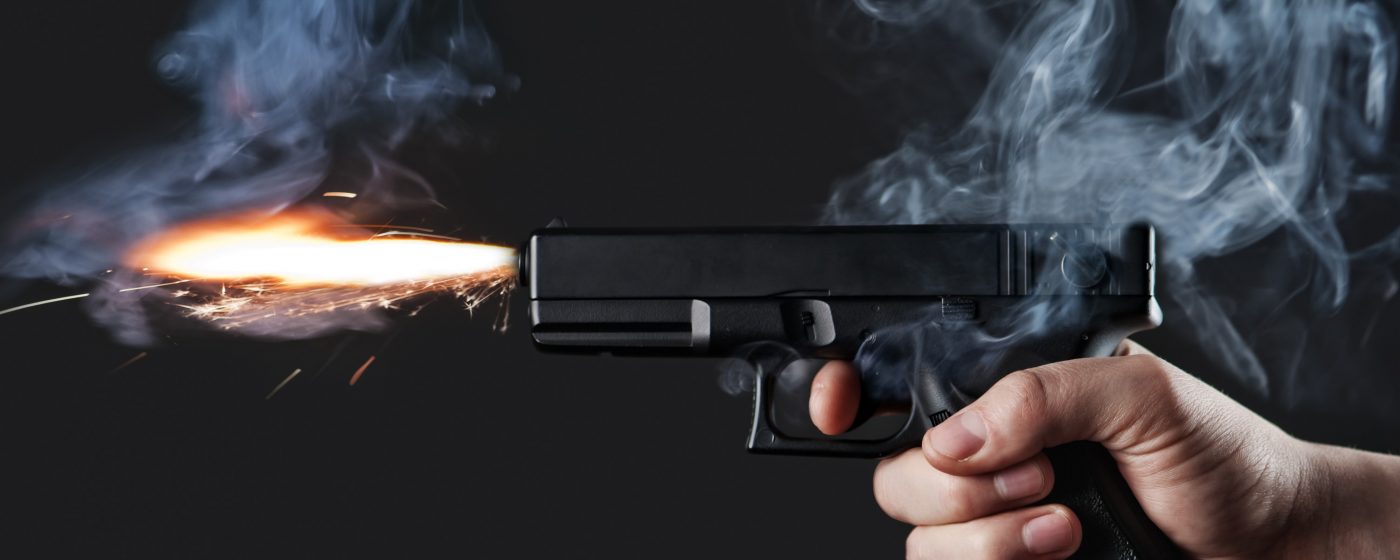Gun violence in popular prime-time broadcast television dramas has increased steadily over almost two decades, a trend that parallels the rise in U.S. homicide deaths attributable to firearms, according to research by the Annenberg Public Policy Center (APPC) of the University of Pennsylvania.
Overall gun violence on popular prime-time dramas doubled from 2000 through 2018, according to the study, published March 17, 2021, in PLOS ONE. More important, gun violence as a proportion of the violence depicted in the shows rose significantly as well.
“Our research found that gun use substantially increased from 2000 to 2018 on prime-time TV dramas in the U.S., a trend that paralleled the use of firearms in homicides,” said APPC research director Daniel Romer, who co-authored the paper with APPC’s Patrick E. Jamieson. “Just as the entertainment media contributed to the uptake of cigarettes among vulnerable youth, our findings suggest that it may be doing the same for guns.”
“The association between the rise of gun violence in popular US primetime television dramas and homicides attributable to firearms, 2000-2018” was published in PLOS ONE.
Highlights
- Gun violence on popular prime-time TV dramas increased steadily from 2000 through 2018, both in absolute terms and as a proportion of the violence depicted.
- The rise in gun violence as a percentage of the violence on these shows statistically paralleled the increase in the use of guns in U.S. homicides, especially for people ages 15 to 24.
- The odds of gun violence as a percentage of the violence on these shows increased 81% over almost two decades; the odds of a U.S. homicide being attributable to guns for people ages 15-24 increased 93%.
- The research was based on 33 highly rated, prime-time broadcast shows, including “CSI” and “ER” – a total of 1,476 hours of programming – that were coded in five-minute segments for incidents of violence, and CDC homicide data.
Behind the study
Firearm injuries and deaths are increasingly seen as a public health crisis in the United States. In 2018, over 39,000 Americans died in gun-related deaths and there were over 70,000 nonfatal firearm injuries. Young people ages 15 to 24 experience the highest rate of gun homicides and are especially sensitive to media influences that put them at risk of adverse health consequences, such as violence.
The rise in gun violence in the media has long been viewed as a potential cultural influence on behavior. Prior research by the Annenberg Public Policy Center has shown that gun violence in the top-grossing PG-13 movies increased dramatically since the inception of the PG-13 rating in 1985; that PG-13 movies have more gun violence than R-rated films; and that parents see movie gun violence as acceptable for adolescents 15 and up when the violence appears to be justified by the need to defend oneself or others.
But homicide rates have declined among youths in recent decades, suggesting that media portrayals of violence have had little influence on gun violence. The current study challenges that interpretation by proposing that researchers should consider trends in the amount of gun violence compared with other forms of violence in both the real world and on TV. To do this, the researchers examined the rate of gun violence as a proportion of all violence in prime-time television dramas, which are more frequently viewed by adolescents than movies.
“We anticipated that just as gun use has increased in popular movies, the same was true for entertainment on TV,” the researchers wrote in PLOS ONE. “We also hypothesized that if TV gun use serves to normalize the use of guns for violent purposes, this influence should be most apparent in the use of guns versus other violent methods on both TV and the real world.”

How the research was conducted
The APPC researchers analyzed 33 popular TV dramas in the police, medical, and legal genres from 2000 to 2018, selecting shows rated TV-14 that were highly ranked over multiple seasons (see the study for more on the methodology). Among the shows were the police dramas “CSI: Crime Scene Investigation,” “NCIS” and “How to Get Away with Murder,” legal shows “The Good Wife” and “JAG,” and medical hits “Grey’s Anatomy” and “ER.”
In all, 1,476 hours of programming were watched by trained research assistants who coded each five-minute segment of the show’s episodes for the presence of violence and the use of firearms. The researchers calculated the percentage of segments for each show for each of three metrics – violence, gun use, and the proportion of violence using guns.
“Our research program on long-term trends in entertainment media popular with adolescents enables us to identify trends that may not otherwise be evident,” said Patrick E. Jamieson, director of APPC’s Annenberg Health and Risk Communication Institute (AHRCI). “This is especially the case for behaviors that may be harmful, such as the use of firearms.”
The researchers also calculated the proportion of homicides attributable to firearms for three age groups – 15-24, 25-34, and 35+ – based on data from the Centers for Disease Control and Prevention (CDC).
The rise in TV gun violence
The analysis showed that while annual percentages of TV violence from 2000 to 2018 peaked in 2011 and then declined slightly, gun violence rose steadily over that time – from 4.5% of the TV drama segments in 2000 to 9.0% in 2018. The percentage of violent segments that contained gun violence rose from 21.1% in 2000 to 33.3% in 2018.
That metric – gun violence within violent segments – paralleled trends in homicides attributable to firearms in all three age groups, and the strongest statistical relationship was seen among young people ages 15 to 24.
“The increase in TV gun violence was predictive of firearm violence for all age groups, not only as measured by its absolute prevalence but also by its proportion of violent scenes,” which may be the more relevant measure, the researchers said.
Hollywood and gun violence
The researchers said that while this kind of correlational study cannot demonstrate causal conclusions about the relationship between TV gun violence and real-world gun violence, the findings are consistent with the hypothesis that gun violence in the media may contribute to the real-world use of guns.
“We don’t think you can discount the role of the media just because real-world gun homicides have gone down in recent years,” Jamieson said. “Even if overall violence has gone down, the use of guns for violent purposes is still going up, particularly for young people.”
Romer added, “We have to start considering whether Hollywood’s portrayal of gun violence in order to increase the excitement of its entertainment is actually contributing to the gun violence epidemic. We think additional research is needed to see if that is the case.”
The researchers concluded, “We recognize that it is unlikely that exposure to TV content is the major source of the longstanding higher rate of gun victimization in youth. However, our findings do add to concerns that the growing presence of guns in entertainment media contributes to their use, an association especially evident in young people. Further research is needed to determine whether exposure to gun violence in entertainment media serves to promote the use of guns, especially by youth.”
The researchers acknowledged the support of the Robert Wood Johnson Foundation and thanked APPC senior research coordinator Lauren Hawkins and the team of undergraduate research assistants who conducted the coding of the TV dramas.

